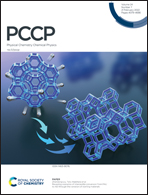Electronic properties and interfacial contact of graphene/CrSiTe3 van der Waals heterostructures†
Abstract
The electronic properties and interfacial contact of the graphene-based heterostructure graphene/CrSiTe3 (Gr/CrSiTe3) are modulated by tuning the interfacial distance, along with application of an external electric field. Our first-principles calculations show that the gap is enlarged to 27.6 meV in Gr/CrSiTe3 when the interfacial distance is reduced to a distance of 2.75 Å. Gr/CrSiTe3 changes from an n-type to a p-type Schottky contact with a decrease in interfacial space. The most significant effect of applying a positive electric field is the presence of a p-type Schottky contact along with an increase of interfacial charge transfer to graphene, while an electric field in the opposite direction enhances the n-type Schottky contact effectively with a decrease of interfacial charge transfer to graphene. The Schottky contact transforms into an Ohmic contact when a positive electric field of 0.41 eV Å−1 is applied to this interface. The work proposes an approach to manipulate the interfacial properties, which can be very useful for future experimental studies and graphene-based interfaces.



 Please wait while we load your content...
Please wait while we load your content...